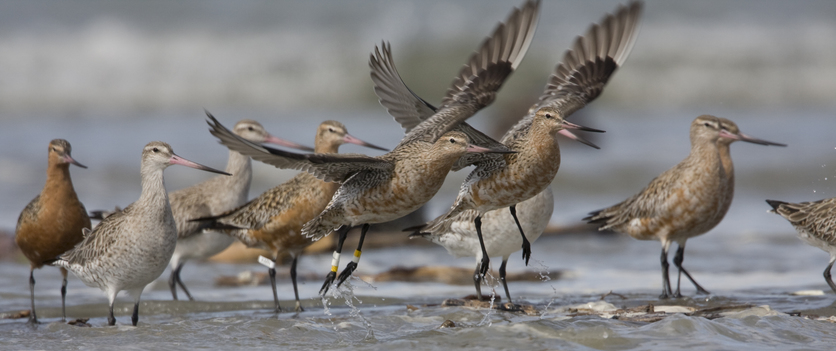One of the requirements for heavier-than-air flying machines is a structure that combines strength with light weight. This is true for birds as well as planes. Birds have many physical features, besides wings, that work together to enable them to fly. They need lightweight, streamlined, rigid structures for flight. The four forces of flight – weight, lift, drag and thrust – affect the flight of birds.
Physical features
Flying birds have:
- lightweight, smooth feathers – this reduces the forces of weight and drag
- a beak, instead of heavy, bony jaws and teeth – this reduces the force of weight
- an enlarged breastbone called a sternum for flight muscle attachment – this helps with the force of thrust
- light bones – a bird’s bones are basically hollow with air sacs and thin, tiny cross pieces to make bones stronger – this reduces the force of weight
- a rigid skeleton to provide firm attachments for powerful flight muscles – this helps with the force of thrust
- a streamlined body – this helps reduce the force of drag
- wings – these enable the force of lift.
Wings
The shape of a bird’s wing is important for producing lift. The increased speed over a curved, larger wing area creates a longer path of air. This means the air is moving more quickly over the top surface of the wing, reducing air pressure on the top of the wing and creating lift. Also, the angle of the wing (tilted) deflects air downwards, causing a reaction force in the opposite direction and creating lift.
Larger wings produce greater lift than smaller wings. So smaller-winged birds (and planes) need to fly faster to maintain the same lift as those with larger wings.
Wing loading tells you how fast a bird or plane must fly to be able to maintain lift: wing loading = weight/wing area (kilograms per square metre).
A smaller wing loading number means the bird/plane can fly more slowly while still maintaining lift and is more manoeuvrable.
Gliding
When a bird is gliding, it doesn’t have to do any work. The wings are held out to the side of the body and do not flap. As the wings move through the air, they are held at a slight angle, which deflects the air downwards and causes a reaction in the opposite direction, which is lift. But there is also drag (air resistance) on the bird’s body, so every now and then, the bird has to tilt forward and go into a slight dive so that it can maintain forward speed.
Soaring
Soaring flight is a special kind of glide. Birds that fly over the land soar on a rising air current called a thermal. Because the air is rising, the bird can maintain its height relative to the ground. Albatross also soar without flapping their wings, sometimes for hours at a time. They use dynamic soaring – a technique that takes advantage of ocean winds to provide lift while weaving an S pattern over wave tops and troughs. Albatross use this type of soaring to support their multi-year voyages at sea.
Flapping
Birds’ wings flap with an up-and-down motion. This propels them forward. The entire wingspan has to be at the right angle of attack, which means the wings have to twist (and do so automatically) with each downward stroke to keep aligned with the direction of travel.
A bird’s wing produces lift and thrust during the downstroke. The air is deflected downwards and also to the rear. The bird reduces its angle of attack and partially folds its wings on the upward stroke so that it passes through the air with the least possible resistance. The inner part of the wing has very little movement and can provide lift in a similar way to gliding.
Obtaining thrust
Birds obtain thrust by using their strong muscles and flapping their wings. Some birds may jump from a tree to give them forward thrust for flight. Others may use a running take-off from the ground.
Different flight abilities
Different birds have different adaptive features to meet their flight needs:
- Some birds are small and can manipulate their wings and tail to manoeuvre easily, such as the pīwakawaka – fantail.
- The hawk, with its large wingspan, is capable of speed and soaring.
- Toroa/albatross have biological and behavioural adaptations that allow them to fly for almost 1,000 kilometres per day.
- Gannets and seabirds are streamlined to dive at high speeds into the ocean for fish.
- Godwits, although small, are equipped to fly long distances.
Activity ideas
Continue the learning with your students with one or more of these activities
- Tracking E7 – explore the incredible flight of a special bird known as E7 to learn about the migratory flight of bar-tailed godwits from New Zealand.
- Birds and planes – explore the importance of wing shape and size and how this determines the flight capabilities of birds and planes.
- Observing wings for flight has suggestions on how to use the interactive Wings for flight graphic organiser. Wings for flight is useful as a pre-test or post-test for summative assessment.
Related content
Learn how bird feathers aid with their flight.
There is a lot to know about wings and flight! These articles provide more information: Wings and lift, Wing loading and Wing aspect ratio.
We have re-purposed the popular Building Science Concepts Book 3: Birds: Structure, Function, and Adaptation with an article and interactive linking this great resource with Hub content.
Useful link
News story about the robo-gull – a man-made bird that flies using remote control. It was inspired by da Vinci’s wing-flapping models designed hundreds of years ago. This article includes video of the robo-gull.



